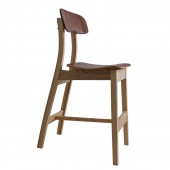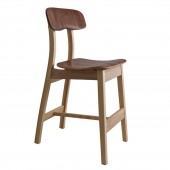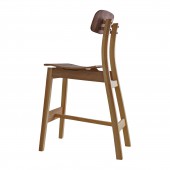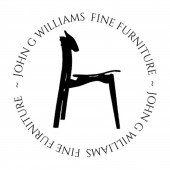Beke Kitchen Bar chair by John G Williams |
Home > Winners > #71063 |
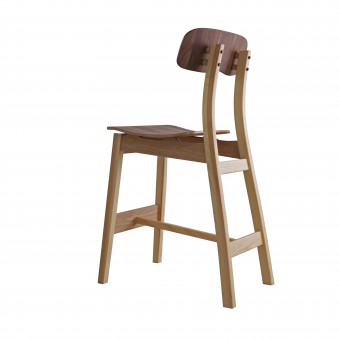 |
|
||||
| DESIGN DETAILS | |||||
| DESIGN NAME: Beke PRIMARY FUNCTION: Kitchen Bar chair INSPIRATION: Beke means 'peace' and 'to be connected to'. This design is intended to put the user at ease, for extended comfort at the breakfast bar – to provide an ergonomic and aesthetic sense of peace. The design attempts to realize this sense of well-being, and at the same time to support a sense of connection with the space at the bar. The design: respects the simplicity of the Danish Modern, and yet incorporates luxurious hardwood in the seat and back; integrates South African Cape Dutch architectural motifs with a sweeping architectural profile; uses a clean ash frame to showcase the richness of local and international hardwoods. UNIQUE PROPERTIES / PROJECT DESCRIPTION: An elegant and stable chair for use at a kitchen bar or counter, in the same range at the Beke dining chair. The chair is designed to be comfortable for extended periods of use, and the geometry of seat, backrest, and footrest have been tailored with this in mind. The seat is a unique custom plywood laminate finished in walnut veneer to an architectural form. The rear legs are formed in two parts: first by steam bending the graceful form, and then laminating for long term dimensional stability. The rails are profiled in an attempt to reinforce the overall lightness and sense of peace, and to support the cantilevered seat over the front rail. OPERATION / FLOW / INTERACTION: The Beke kitchen bar chair sits permanently near or at the kitchen counter. The user easily steps into the chair, using the front foot rail if preferred. The user can readily sit forward to the kitchen bar, given the small angle of inclination. The user is also comfortably supported by the inclined backrest, which remains comfortable for a number of hours. This sustains the most engaged of mealtime conversations, or possibly a shared sports match at a home bar. PROJECT DURATION AND LOCATION: The project was completed over the course of approximately 4 weeks. All design and manufacturing was completed in Johannesburg. FITS BEST INTO CATEGORY: Furniture Design |
PRODUCTION / REALIZATION TECHNOLOGY: The chair design incorporates a number of innovative components: custom plywood seat; steam bent rear legs; coopered backrest; and shaped rails: Custom plywood seat. The seat is formed from 5 plies, which are then finished top and bottom with a walnut veneer. The profile is a custom design that is used to build a purpose made forming press to generate finished seat forms. T nuts are encapsulated in the ply, so that the seat can be securely bolted to the frame with no interruption at all of the top surface of the seat. Steam bent rear legs. The rear legs are steam bent in two pieces; cooled and stabilized; and then laminated to generate the final leg forms. Regular lamination was discarded on account of the excessive glue joints implied; and steam bending alone risked dimensional instability over time. This innovative combination captures the best of both techniques. Coopered backrest. Coopering is the ancient art of constructing curved forms as used in barrel construction. The backrest staves are cut with edges 1 degree off perpendicular so that, when glued together, they pull into the curved form. Modified power tools are used to finish shape the graceful curves. Shaped rails. The rails incorporate forms that echo local Cape Dutch architecture. These are achieved by trimming the rails to custom templates. SPECIFICATIONS / TECHNICAL PROPERTIES: Overall dimensions: 1080mm high x 470mm wide x 670mm deep Seat dimension: 470mm wide x 440mm deep Backrest dimensions: 540mm wide x 200 mm high Seat angle: 3 degrees Backrest angle: 18 degrees Included angle: 15 degrees Seat height: 660 mm Backrest height: 1025mm Weight: 7.0kg TAGS: Beke, kitchen bar chair, south africa, hardwood, curved, danish modern, minimalist, ash, walnut, gracefu RESEARCH ABSTRACT: Research focussed mainly on: the geometry of kitchen bar counter and chair; and the various manufacturing processes required to generate Beke CHALLENGE: The main aesthetic challenge in this project was to conceptualize a design that would be recognizably 'Beke' and congruent with the existing dining chair, without merely looking like an elongated version of the same. The manufacturing challenges were numerous. Combining steam bending with laminating for the rear legs required, in the end, a very complete understanding of the dynamics of steam bending. In particular, how steam bent parts spring back over time required extensive modeling and test work to realize the desired designed end product ADDED DATE: 2018-09-25 00:10:42 TEAM MEMBERS (1) : John G Williams IMAGE CREDITS: John G Williams PATENTS/COPYRIGHTS: UK IP Office Registered Design: 6047912 Holder: John Griffith Williams, 2018 |
||||
| Visit the following page to learn more: http://www.johngwilliamsfinefurniture.co |
|||||
| AWARD DETAILS | |
 |
Beke Kitchen Bar Chair by John G Williams is Winner in Furniture Design Category, 2018 - 2019.· Read the interview with designer John G Williams for design Beke here.· Press Members: Login or Register to request an exclusive interview with John G Williams. · Click here to register inorder to view the profile and other works by John G Williams. |
| SOCIAL |
| + Add to Likes / Favorites | Send to My Email | Comment | Testimonials | View Press-Release | Press Kit |
Did you like John G Williams' Furniture Design?
You will most likely enjoy other award winning furniture design as well.
Click here to view more Award Winning Furniture Design.


